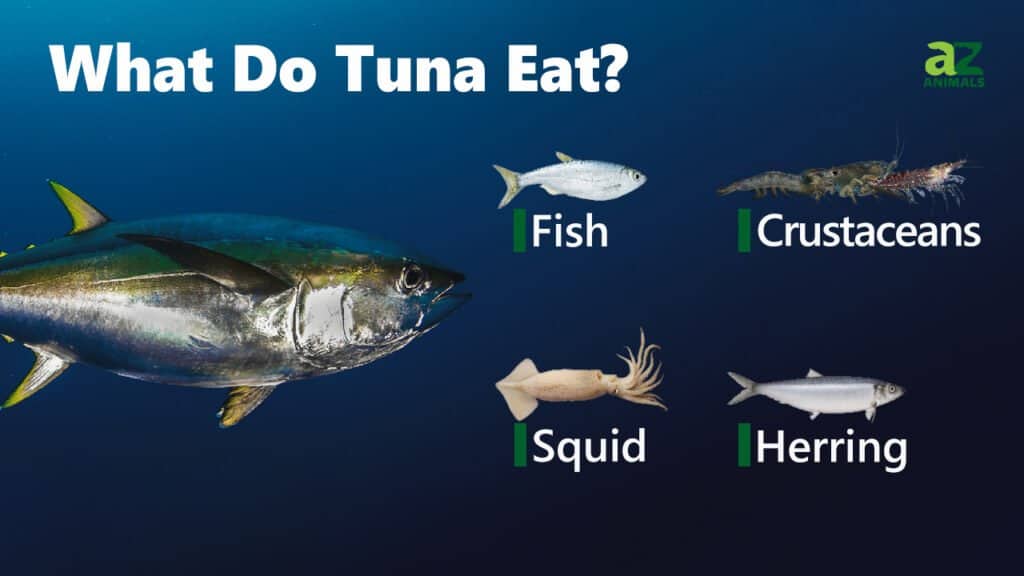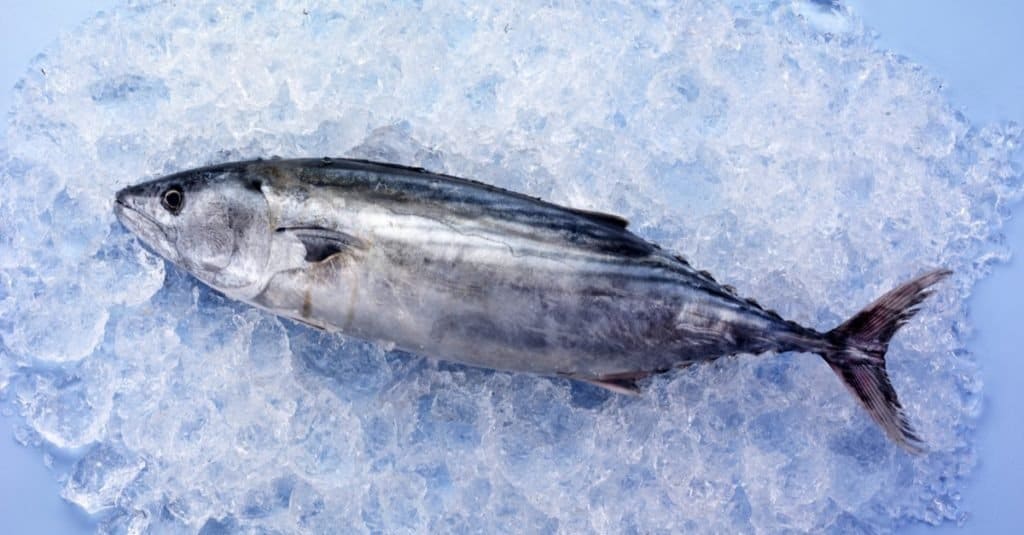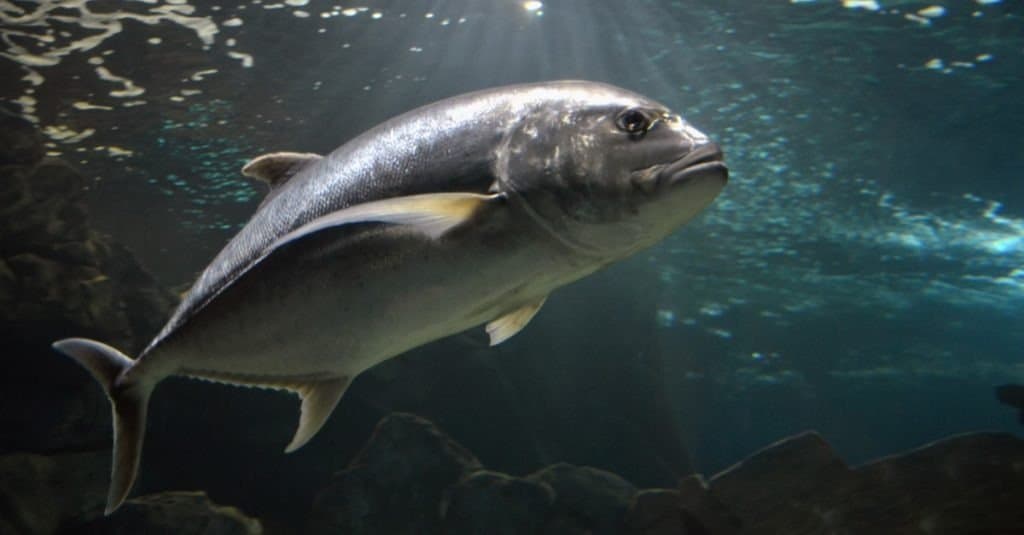Tuna are carnivorous and are a popular food choice among humans. We may eat tuna, but what does a tuna eat?
Each tuna can weigh more than a thousand pounds. They prefer temperate and tropical waters mainly in the Pacific, Indian and Atlantic oceans. They travel in the deep ocean, which makes them pelagic fish.
Their meat is so prized and ubiquitous that they’re at risk of being overfished, so international efforts are being made to protect these migratory fish.
Let’s look at what tuna eat so we understand how our sushi rolls and tuna packets came to be.
What Do Tuna Eat?

Tuna primarily eat shellfish, squid, and fish. Their main diet consists of squid if they’re the type of tuna that hangs out by the ocean’s surface. Tuna that spend most of their time in deep waters tend to eat cephalopods and fish. However, all tuna will eat anything from this list if given the opportunity.
Tuna like to eat:
- Mackerel
- Bluefish
- Surgeonfish
- Menhaden
- Sardines
- Herring
- Surfperches
- Eels
- Shrimp
- Balloon Fish
- Flying Fish
- Toadfish
- Anchovies
- Octopus
- Cuttlefish
- Jellyfish
- Barnacles
- Lobster
- Crab
- Crayfish
- Lantern Fish
- Saury Fish
- Other Tuna
Juvenile tuna eat zooplankton during the early stages of life. Tuna spend so much time swimming around the oceans that they have to eat up to 25% of their body weight every single day just to maintain their powerful muscles.
Why Do People Eat Tuna?
People eat tuna because it’s generally cheap, convenient, and nutritious for the price. However, tuna can also be expensive and some bluefin tuna in Japanese markets get auctioned off for thousands of dollars.
There are several tuna species including the most famous: albacore and bluefin. Yellowfin tuna and skipjack tuna also make it onto human menus in mass quantities. Most of the other tuna are safe from commercial fishing but are just as yummy as the big guns. Tuna are easily caught in mass quantities because they travel the oceans in huge schools.
A tuna’s meat isn’t your typical whitefish and is dark red or pink in color. That’s because tuna have powerful muscles which they need so they can migrate huge distances at about 50 mph. That isn’t to say that all tuna meat is colored; albacore tuna has white flesh yet still goes through extensive migrations.
Most tuna is canned, but the prime pieces are used in dishes like sushi. Tuna has been a popular source of food for centuries and it’s proven that moderate tuna consumption can aid heart health due to the amount of omega-3 fatty acids.
Use caution if you have a taste for tuna. Because they live for up to 40 years and are a top predator, their meat accumulates large mercury levels. Because of this, it’s recommended that consumption be limited to three servings per week.

People eat tuna because it’s high in omega 3 fatty acids.
©CKP1001/Shutterstock.com
Do Tuna Have Any Predators?
Tuna are a top predator and do not have many predators of their own once they’re adults. Sharks, billfish, dolphins, and whales will make a hefty meal out of them if they get the chance.
As juveniles, larger fish and birds take advantage of their size and eat them. Their eggs are such a popular food item for other animals that a female tuna will lay around 1 million eggs per season.
Humans are some of the biggest predators due to overfishing. Conservation efforts are being put in place in some countries. The problem is that tuna undergo such a huge migration that they’ll still swim through waters where they can be caught by the thousands. Despite this, tuna stock is starting to rise again via the sanctions on their fishing.
Do Tuna Eat Other Tuna?

©Guido Montaldo/Shutterstock.com
Yes, tuna will eat smaller tuna. Since they’re opportunistic feeders, if they come across a smaller tuna that’s a good meal size, they won’t hesitate to consume it.
Tuna prefer to swallow whatever they’re eating whole. That’s because their mouths are rounded and aren’t designed for biting and shredding. That’s why huge tuna don’t attack people.
Since they can be microscopic when they hatch from their egg, they go through a phase where they make good prey for their own kind and everyone else in the ocean. Not many are expected to make it to adulthood.
Why Does My Tuna Can Say Dolphin Free?
When a fisherman finds a tuna, they find a huge school of tuna. Before government sanctions and laws were put in place, fishing boats would drag a huge net through the water where the school resided and catch anything in the water. They would then keep the tuna and throw anything else back into the ocean.
Lots of dolphins were killed during this fishing process. Dolphins like to swim near schools of tuna, so they became entangled in the nets. In the 1990s, consumers demanded this change, and the dolphin-safe label was born.
It’s a misconception that tuna are eating the dolphins. Tuna aren’t designed to rip and shred prey. Even the smallest dolphin is much too large for a tuna to swallow whole.

Tuna swallow their prey whole because their rounded mouths can’t shred meat.
©jurgal photographer/Shutterstock.com
Why Does My Cat Want Tuna Can Water?
Your cat wants tuna water because it is a fish-scented bowl of water. It hydrates them while also tasting better than just plain tap water. Since cats are notorious for dehydrating themselves, even mixing a little tuna water into their daily water bowl can make them more interested in drinking.
Never feed a cat tuna that’s been packed in oil. This can give them diarrhea and a sour stomach. Also, don’t give tuna water as your cat’s primary food source. It’s low in the kind of nutrients that cats need and should only supplement a regular diet.
Just like in humans, overconsumption of tuna by your cat can lead to mercury concerns. Tuna water servings should be doled out sparingly. Some tuna contains spices, so make sure the tuna you feed your cat is plain.
The photo featured at the top of this post is © lunamarina/Shutterstock.com
Thank you for reading! Have some feedback for us? Contact the AZ Animals editorial team.






